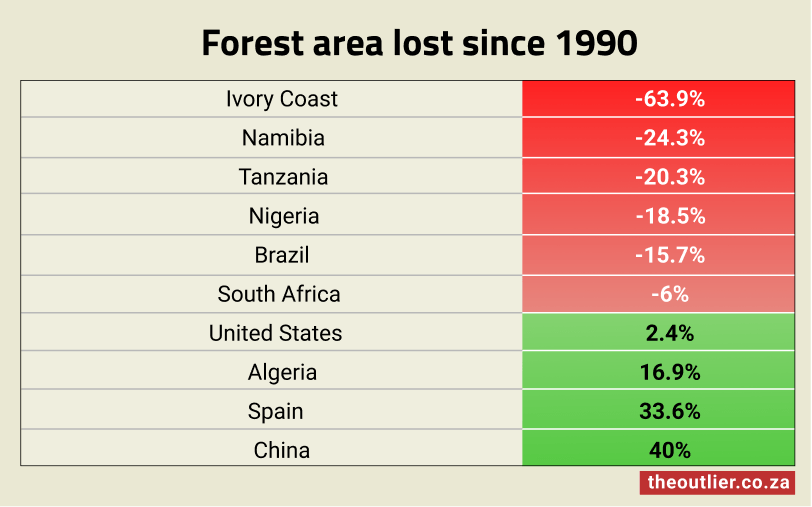Forests are cleared to make space for housing, industries, businesses and for agriculture. (Photo by ADITYA AJI/AFP via Getty Images)
Natural forests of indigenous trees create ecologically complex and biodiverse environments, whereas plantations are managed plantations of exotic trees such as pine and eucalyptus that are grown for harvesting and logging.
In 2010, South Africa’s natural forests covered 3.97 million hectares, an area equivalent to a third of the Western Cape.
Just 11 years later, urbanisation, farming, mining and other activities had wiped out 23 900ha of natural forest — an area almost the size of Table Mountain National Park destroyed.
Why are our forests disappearing?
When populations increase there is a knock-on effect. Forests are cleared to make space for housing, industries, businesses and for agriculture.
Many South Africans still cook over open fires, which means trees are cut down for wood. The good news is that there are alternatives such as the “non-electric slow cooker” that could decrease deforestation. You bring your food to a boil and remove it from the heat. Then you put your pot in the Wonderbag and it continues to cook and remain warm for up to eight hours, without using any additional energy sources.
Why is deforestation a problem?
Forests act as carbon sinks, absorbing carbon dioxide and storing it in vegetation and soil. When forests are cleared, the stored carbon is released back into the atmosphere, contributing to greenhouse gas emissions.
About 80% of amphibian species, 75% of bird species and 68% of the world’s mammal species call indigenous forests their home. Habitat loss is a leading reason for extinction.
Without plants, erosion increases and fertile topsoil is lost. The increased sedimentation in rivers affects the water cycle.
Deforestation is a problem around the world. The West African country of Côte d’Ivoire is known for its rich biodiversity and tropical rainforests, but it has lost more than 60% of its indigenous forests since 1990.

From 2015 to 2021, South Africa lost about 5% of its total primary forest area — or more than 6 000 hectares, the equivalent of 6 373 rugby fields.
Almost a third of the total loss took place in 2017. In June of that year, devastating fires swept through the Knysna and Tsitsikamma forests over 12 days. Seven people died and about 20,000 hectares of vegetation was lost.

What is a carbon sink?
A carbon sink is something that absorbs more carbon than it releases into the atmosphere.
The ocean is the largest natural carbon sink. Wetlands, soil and forests are other important carbon sinks. But their ability to store carbon can be affected by pollution and deforestation.
To help combat this, artificial carbon sinks can be created by replanting trees. Another method that has been touted is ocean fertilisation. It involves introducing iron or other nutrients to surface water to encourage blooms of microscopic marine plants (phytoplankton) that absorb carbon dioxide through photosynthesis. But this idea is controversial because it may cause further harm.
First prize is still reducing the amount of carbon we pump into the atmosphere by burning fewer fossil fuels.
This is an edited version of the article first published by Treevolution. Subscribe to their newsletter here.